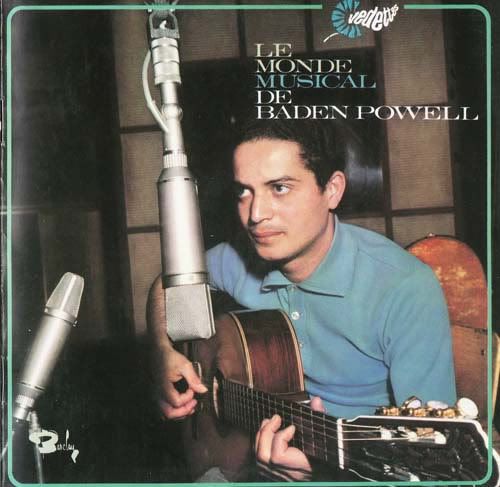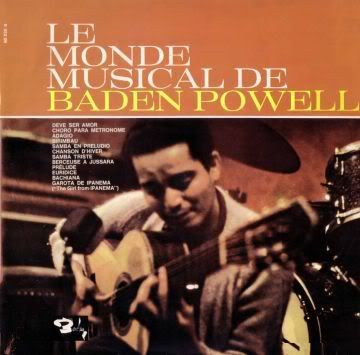Milton Nascimento
“MILTON”
Released in 1970 on EMI/Odeon
Remastered at Abby Road in 1994
Milton Nascimento tends to get a bad rap these days among music connoisseurs. Much of that is his own doing: since he became an international jazz-fusion star in the late 1970s, his records just became worse and worse. Another reason why “jazz-fusion” is often synonymous with the Devil’s work. Satan may torture music snobs with Britney Spears or Pink when they arrive in his fiery domain, but when the Prince of Darkness wants to just chill out and relax with some of his demonic underlings, he puts some jazz-fusion on the box. Trust me on this.
In a way, that all started with Milton’s first album for A&M (Courage) produced by Rudy Van Gelder and featuring Herbie Hancock, Hubert Laws, Airto, Eumir Deodato and others, but his work really becomes ‘fusion’ in his second album for A&M, recorded seven years later in L.A. and featuring Wayne Shorter, Hancock and Airto again. That record is actually not that bad in itself (it’s also not that good), but only once you’ve appreciated WHY all those American heavyweights of jazz were so interested in Milton in the first place. The key to that question lay in his records released in Brazil in the interim between 1969 and 1976. Most of that second A&M record was comprised of songs he had already recorded and released in Brazil, but with new arrangements and occasionally English lyrics. This 1970 effort is the first of the influential albums where Milton finds his voice. (The one LP between ‘Couragem’ and 1970’s Milton sees him searching for something new but artistically stumbling in the process..)
Backing him up on this record is the psychedelic/progressive band Som Imaginario, a group of musicians from the mountainous interior state of Minas Gerais. Many of these guys — Wagner Tiso, Toninha Horta, Robertinho Silva among them — would go on to be central to Milton’s ‘corner club’ band that would record the amazing “Clube da Esquina” album. This record is essentially gestating the ethereal vibe that would culminate in that landmark — rock numbers tinged with Brazilian funk; languid, pastoral pieces fringed with psychedelic flourish and soaring arrangements; at times sparse, at times grandiose; and all of it capped with Milton’s angelic voice heard here for the first time as it would come to make him famous — rooted in the Baroque gold-leafing of his church-choir boyhood, as someone once said, “In Milton’s voice, you can HEAR the mountains.” The statement is spot on. There is a melancholy in his tone and phrasing, but also a enveloping warmth, a permanence and solidity in the face of tectonic change. A nostalgia for that to which there is no returning. Saudades.
There is something unmistakable in Milton’s melodies, in the intervals he chooses to express the layered complexity. It’s this that makes his compositions immediately recognizable no matter who is performing them — case in point is Elis Regina, his most important interpreter, she recorded a ton of his songs, and all of them stand out as high points on her records. Unlike some of his contemporaries (Caetano or Gil, for example) a lot of his lyrics are really nothing special. But the vibe he and his fellow Mineiros created on these records from 1970 to 1976 was unmatched and, in my opinion, deserving of much more attention than they’ve received, overshadowed as they were by the iconic Tropicalístas based in São Paulo. Caetano Veloso remarks in his memoir Verdade tropical about a conversation he and Gilberto Gil had on the eve of their exile from Brasil, where they reflected that Milton Nascimento was the most important thing happening (after themselves, of course…) in Brasil’s musical world at the time, that he was deepening what they had begun. This may be taking too much credit for himself, as Caetano is wont to do. I think of Milton and the Clube da Esquina crowd as having been working on something different, something perhaps more ‘Pan-Latino’ in its vision, as we’ll see in his subsequent albums that I hope to share here soon. But the compliment still stands.
The songs here are not quite as developed as the ones that would come together on ‘Clube da Esquina’ but they still make for a very solid listen and one of my favorite albums from 1970 in Brasil. If the haunting ‘Durango Kid’ does not grab you, or the beautiful ‘Pai Grande’ which begins quietly enough but soon becomes nearly unhinged swell of acoustic of reverb-laden percussion, organ, recorder, and Milton’s voice rising above the din. This is probably the high point of the record for me, and hints at the experimentation that we’ll find on his Milagre Dos Peixes record a few years after this, but in a more accessible form. The album as a whole is very similar to Nelson Angelo & Joyce’s album from 1972 – very relaxed and dreamy but with more of a sense of urgency to it.
Note that tracks 10-13 are bonus tracks not on the original album.
Milton Nascimento – Milton (1970) in 320 kbs
Milton Nascimento – Milton (1970) in FLAC LOSSLESS AUDIO.. Available as soon as I find my EAC backup. The original is locked in my bunker in the Kaymans.









